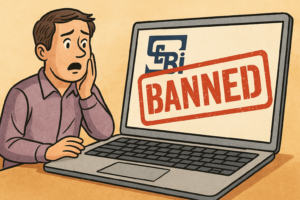In this article, we explore the NoBroker Business Model to explain and understand how the Business Model of NoBroker is structured and to learn about how NoBroker makes money.
NoBroker is an Indian technology-driven real estate platform that connects property owners and tenants without any intermediaries. It was founded in 2014 by three seasoned professionals – Akhil Gupta, Amit Agarwal, and Saurabh Garg – with the aim of making the real estate rental and buying process more transparent and efficient. The founders had themselves faced several challenges while searching for rental properties in India, and they realized that the traditional broker-based model was broken. This realization led them to create NoBroker – a platform that eliminates the need for middlemen, thereby making property transactions more cost-effective and user-friendly.
In this blog post, we will explore the business model of NoBroker using Alexander Osterwalder’s Business Model Canvas. This framework allows us to dissect and understand the different components of the business, including its value proposition, customer segments, revenue streams, and cost structure.
- Value Proposition
NoBroker’s primary value proposition revolves around eliminating the middlemen or brokers from property transactions. This results in significant cost savings for both property owners and seekers. The platform offers a range of services to cater to the diverse needs of its users, including rental listings, property buying and selling, and home services.
Some key aspects of NoBroker’s value proposition include:
a. Cost Savings: By cutting out the middlemen, NoBroker saves customers from paying hefty brokerage fees, which can range from one to two months’ rent or 1-2% of the property value in India.
b. Comprehensive Database: NoBroker maintains an extensive database of property listings that is regularly updated, ensuring users have access to the latest information and options.
c. Verified Listings: The platform verifies property owners and listings to minimize fraud and ensure that users have accurate information.
d. User-friendly Interface: NoBroker’s website and mobile app offer an intuitive and easy-to-use interface, making property search and transactions seamless.
e. Personalized Recommendations: NoBroker uses artificial intelligence and machine learning algorithms to provide personalized property recommendations based on user preferences.
f. Value-added Services: In addition to property listings, NoBroker offers services like rental agreements, home loans, packers and movers, and home cleaning to facilitate a smooth end-to-end experience for users.
- Customer Segments
NoBroker caters to a broad range of customer segments in the real estate market. Its primary customers can be divided into two categories:
a. Property Owners: These are individuals who own residential or commercial properties and wish to rent, lease, or sell them. NoBroker enables property owners to list their properties on the platform, connect with potential tenants or buyers, and close deals without the need for brokers.
b. Property Seekers: Property seekers include individuals looking for rental properties or those interested in purchasing residential or commercial properties. NoBroker provides these users with a comprehensive database of verified listings, personalized recommendations, and value-added services to simplify their property search.
In addition to these primary customer segments, NoBroker also caters to the needs of various other stakeholders in the real estate ecosystem, such as home service providers, financial institutions, and property developers.
- Channels
NoBroker uses a variety of channels to reach its customers and deliver its value proposition. These channels include:
a. Online Platform: The company’s primary channel is its online platform, which consists of a website and mobile app. Users can access the platform to search for properties, connect with property owners, and avail various value-added services.
b. Marketing and Advertising: NoBroker leverages digital marketing channels like search engine optimization (SEO), search engine marketing (SEM), social media marketing, and content marketing to create awareness and drive user acquisition. The company also uses offline marketing channels
c. such as print media, billboards, and events to reach a wider audience.
d. Customer Support: NoBroker offers customer support through multiple channels, including email, phone, and in-app chat. The customer support team assists users in resolving any issues related to property listings, transactions, or value-added services.
e. Strategic Partnerships: The company has forged partnerships with various stakeholders in the real estate ecosystem, such as financial institutions, home service providers, and property developers. These partnerships help NoBroker expand its service offerings and reach more customers.
- Customer Relationships
NoBroker is committed to maintaining strong relationships with its customers by providing a seamless and transparent property search experience. The company achieves this through:
a. Personalized Recommendations: By leveraging AI and machine learning algorithms, NoBroker offers personalized property recommendations based on user preferences and requirements.
b. Verified Listings: The platform verifies property owners and listings, ensuring that users have access to accurate information and can make informed decisions.
c. Customer Support: NoBroker’s customer support team is available through multiple channels to address user concerns and provide assistance throughout the property search and transaction process.
d. Feedback Mechanism: The company encourages users to provide feedback on its services, which helps NoBroker continuously improve its offerings and enhance customer satisfaction.
- Revenue Streams
NoBroker generates revenue through a combination of subscription fees, transaction fees, and commissions from value-added services. Some key revenue streams include:
a. Subscription Plans: The platform offers various subscription plans for property owners, which grant them access to different features and services, such as increased listing visibility and priority customer support.
b. Tenant Plans: NoBroker offers subscription plans for tenants, allowing them to access premium listings, avail priority customer support, and get personalized recommendations.
c. Transaction Fees: The company charges a nominal transaction fee from property owners for successful deals closed on the platform.
d. Value-added Services: NoBroker earns commissions from home service providers, financial institutions, and other partners for services availed by its users.
- Key Resources
NoBroker’s key resources can be categorized into the following:
a. Intellectual Property: The company’s proprietary algorithms, software, and databases form the backbone of its platform and value proposition.
b. Skilled Workforce: NoBroker relies on its team of professionals, including software engineers, data scientists, marketing experts, and customer support representatives, to deliver its services and maintain customer relationships.
c. Infrastructure: The company’s physical infrastructure includes its servers, data centers, and office spaces, which enable it to manage and maintain its online platform and support its workforce.
- Key Activities
NoBroker’s key activities revolve around maintaining and improving its online platform, expanding its user base, and enhancing its service offerings. Some of these activities include:
a. Platform Development and Maintenance: The company invests in continuous development and maintenance of its website and mobile app to provide users with an intuitive and user-friendly interface.
b. Data Management: NoBroker regularly updates its database of property listings and verifies property owners to ensure users have access to the latest information.
c. Marketing and Advertising: The company undertakes marketing initiatives to create awareness, drive user acquisition, and build its brand.
d. Customer Support: NoBroker provides customer support to assist users in resolving issues and ensuring a seamless property search experience.
e. Strategic Partnerships: The company seeks to form partnerships with various stakeholders in the real estate ecosystem to expand its service offerings and reach more customers.
- Key Partners
NoBroker’s key partners include:
a. Financial Institutions: The company partners with banks and other financial institutions to offer home loans and other financial services to its users.
b. Home Service Providers: NoBroker collaborates with home service providers, such as packers and movers, home cleaning services, and interior designers, to offer value-added services that enhance the overall user experience.
c. Property Developers: The company works closely with property developers to list new projects on the platform and promote them to potential buyers.
d. Technology Partners: NoBroker partners with technology providers to enhance its platform, develop new features, and improve its algorithms for personalized recommendations.
e. Marketing and Advertising Partners: The company collaborates with marketing and advertising agencies to promote its brand and services across various online and offline channels.
- Cost Structure
NoBroker’s cost structure can be broadly categorized into the following components:
a. Platform Development and Maintenance: The company incurs costs related to software development, server maintenance, and data management to maintain and improve its online platform.
b. Workforce Expenses: NoBroker’s workforce, including software engineers, data scientists, marketing professionals, and customer support representatives, forms a significant portion of its cost structure.
c. Marketing and Advertising: The company incurs costs for various marketing and advertising initiatives to promote its brand, acquire users, and maintain customer relationships.
d. Infrastructure: NoBroker’s physical infrastructure, such as data centers and office spaces, contributes to its cost structure.
e. Partnerships and Commissions: The company incurs costs for partnering with financial institutions, home service providers, and other stakeholders in the real estate ecosystem, as well as commissions paid to them for services availed by its users.
In conclusion, NoBroker’s business model is a disruptive force in the Indian real estate market. By leveraging technology to eliminate the need for middlemen, the company has significantly reduced transaction costs for property owners and seekers. NoBroker’s value proposition, customer segments, channels, and customer relationships work in tandem to create a seamless and user-friendly property search experience.
The company’s revenue streams, key resources, key activities, key partners, and cost structure contribute to a scalable and sustainable business model. NoBroker’s success is a testament to the power of innovation and the potential for technology-driven platforms to revolutionize traditional industries. As NoBroker continues to grow and expand its services, it remains a valuable case study for entrepreneurs, business leaders, and academics interested in understanding the dynamics of disruptive business models in the digital age.
Did you know? Real estate agents like to use our coworking space in Bangalore.
Learn more about our coworking space on our YouTube channel Work Theater Studios where we talk about a variety of topics including personal finance, entrepreneurship, business and life.
Did you know? We also have a private theater in Bangalore.




